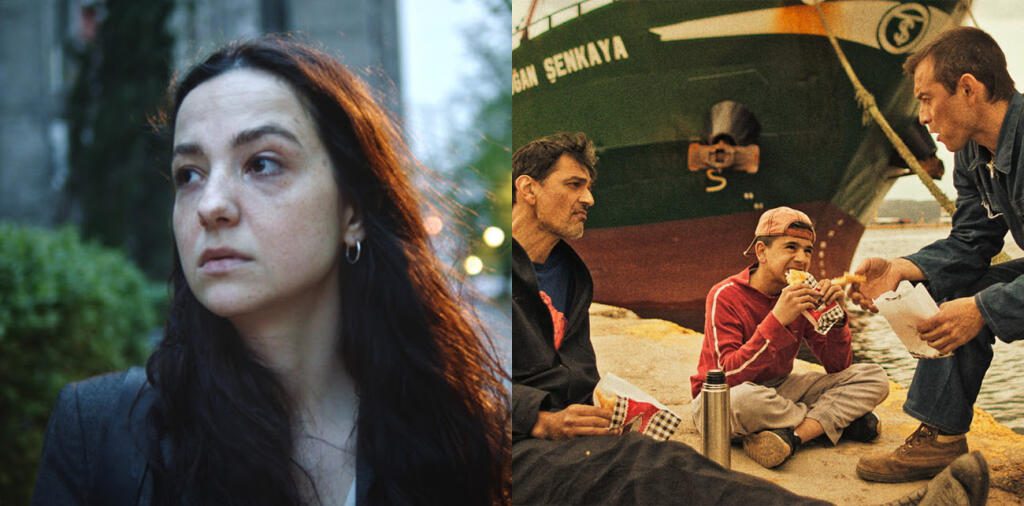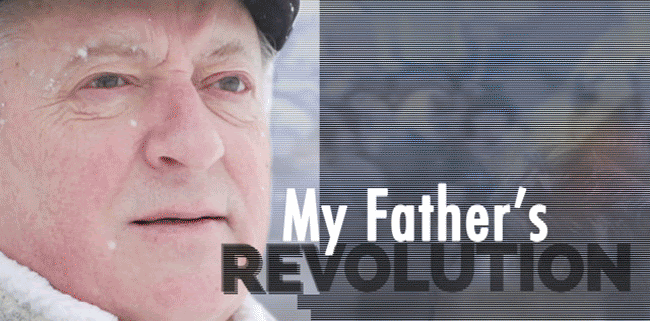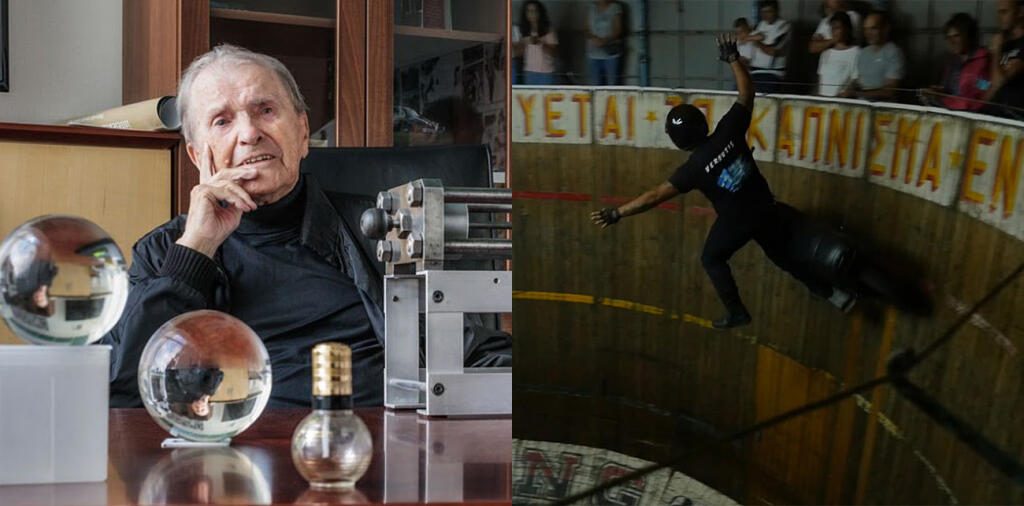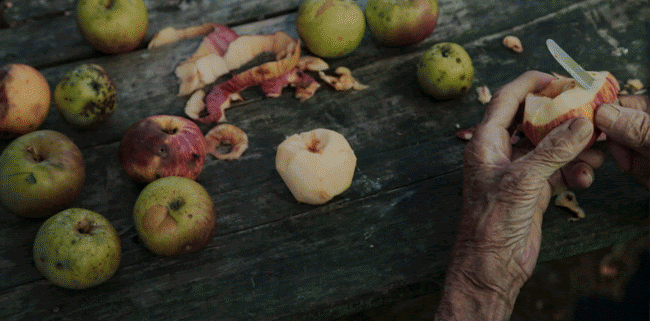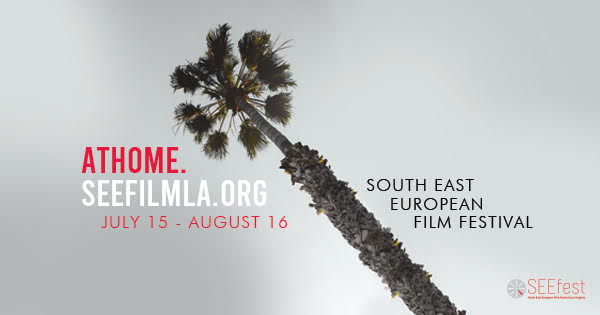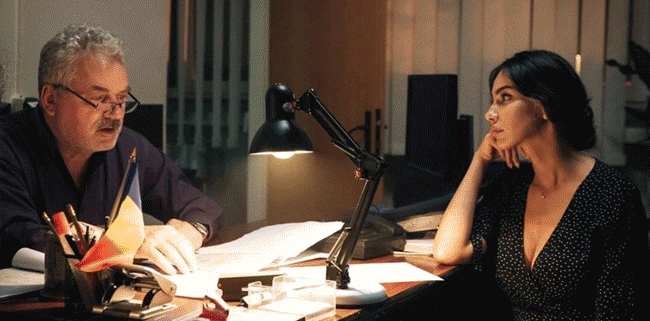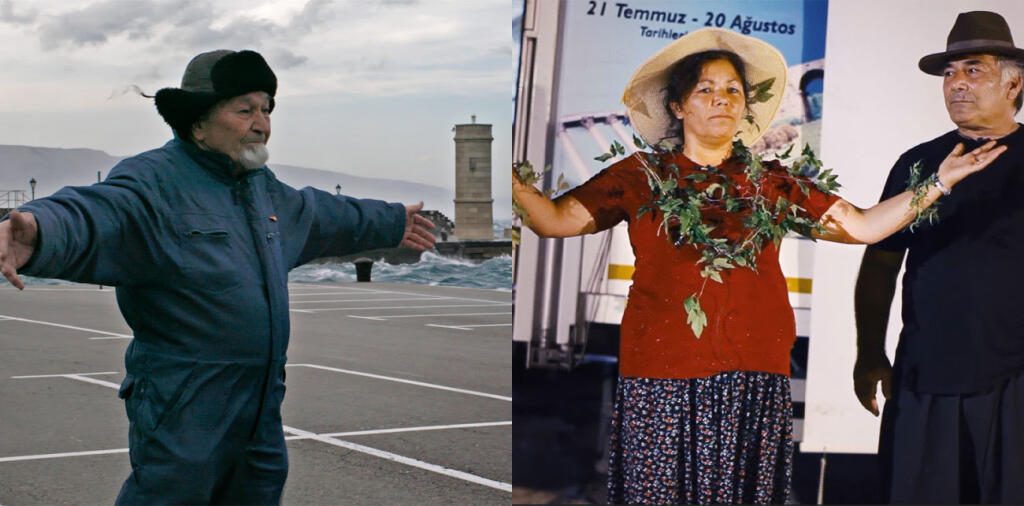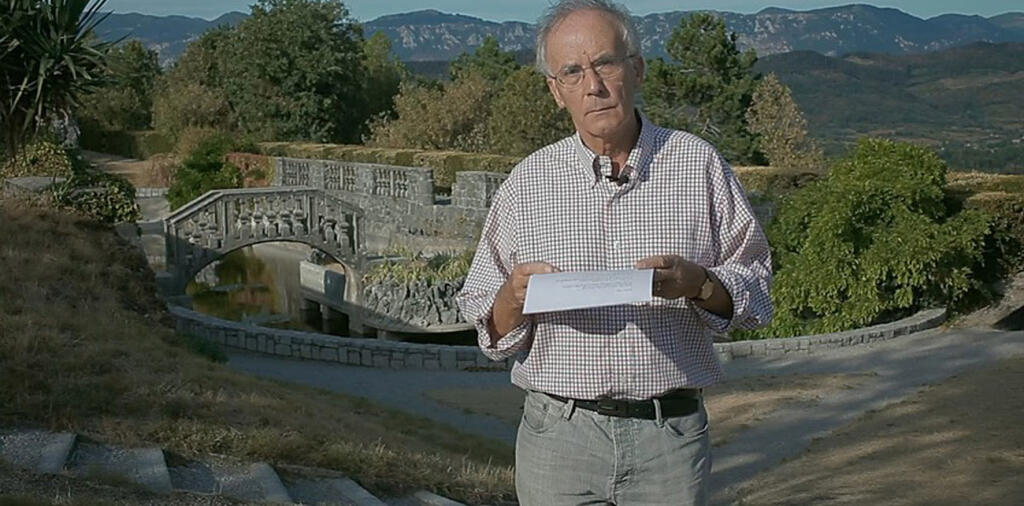Olives of the Mediterranean
A field of olive trees.
Meandering between the parcels of land are walls of loosely-stacked stones, dividing the trees among neighbors. From a high vantage point, the walls are hidden beneath the trees’ leaves, slim and dappled with sunlight, and in such abundance that they form a sea of their own in the field. The branches that hold them may seem fragile, but they grow from trunks that have weathered hundreds—if not thousands—of years. The trunks widen at the base, forming a kind of enclosure at the heart of the tree, where one might have room to step inside and see from the tree’s point of view.
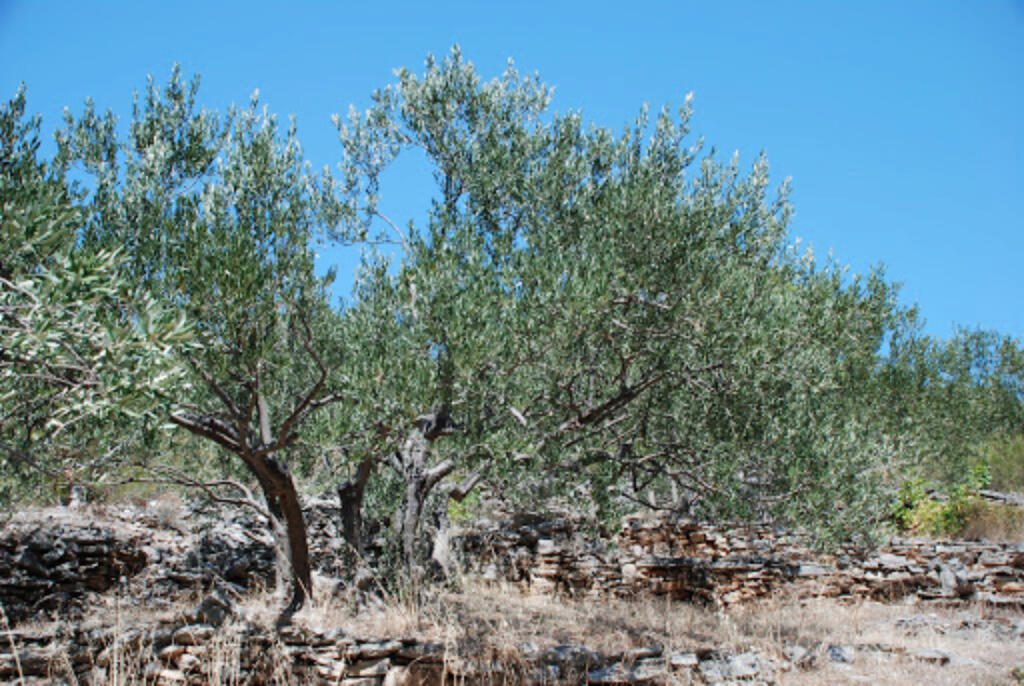
This is a typical sight on the Dalmatian coast of Croatia, where every fall villagers follow worn trails to their respective parcels of land. In this region, olive trees often grow on sloped and ragged land, found all over the rocky and hilled islands of Dalmatia. As soon as the olives begin to fall from the branches, the time has come to collect them, since the longer they sit apart from the tree, the more they will sour. The work can be tedious, especially since most of the farmers are older—a problem that holds true across much of the Mediterranean. Spread out in a wide international diaspora, younger relatives are rarely around during this time of year to help and only the older population remains to tend to the olive trees.
After gathering thousands of kilos of olives, the next destination is the olive press. Green and purple olives tumble into the machine, where they are compressed and out flows slick, smooth green oil in waves. The oil fills large bottles, encased in woven coverings, and stored away in cellars, to be cooked with and shared, or sold and shipped away. Those who do not participate in the industry make only enough oil for themselves, their families, and close friends and relatives. A gift of home-grown oil is a sign of great gratitude, knowing the care and effort that goes into making it.
And the gift is always appreciated since olive oil is the base of virtually every dish in the region. The Mediterranean basin produces around 90% of the olives in the world and also consumes the vast majority of them, making olive trees a fundamental part of not only the landscape but also the regional food. As the meeting point of cultures from three continents, the Mediterranean basin has allowed a wide variety of olive oil-based foods to flourish over the centuries, ranging from grilled fish sprinkled with olive oil using a branch of rosemary to soparnik to simple pasta with olive oil, garlic, and parsley.
More recently, as environmental issues have come to the fore, the region is learning to take measures to protect the olives and their traditions. Fortunately, olive trees are relatively stable and capable of growing on their own in the wild; an estimated 70% of the world’s olive orchards are solely grown on rainwater, without any irrigation system.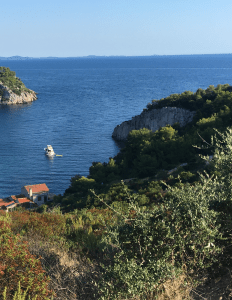
However, the lack of farmers in the younger generation endangers the tradition of making olive oil, and already many have accepted that their fields will become wild and overgrown as they can no longer maintain them. Although olives are often praised for their great health benefits, recent literature and films have aimed to go beyond science by showing the cultural traditions surrounding the over 3000-year-old cultivation of olives and encourage the preservation of these traditions.
Unlike most fruits, which grow from the pit, olives grow from other olive trees. Root cuttings are the common method of propagation. Much like the traditions surrounding them, olives grow from the root, from their very beginnings, before they can stretch their own branches into the field. And like the ancient trunks, every effort is being made to help the traditions of olives of the Mediterranean continue for many centuries more.
South East Europe Loves Chess!
The super-successful Netflix show, The Queen’s Gambit, shone the spotlight on South East Europe’s long history of world-class chess. It’s no coincidence that many world-masters have emerged from SEE. Grandmaster is the highest title one can be awarded in chess, and former Yugoslavia is a region that birthed an unusual amount of them.
This month international chess media profiled living legend, Ljubomir Ljubojevic from Serbia, on his 70th birthday. As Grandmaster and one of the world’s best players, he was inspired by Yugoslavia’s chess boom in the 1950s and became known for his daring and brilliant tactic – as well as good looks.

Nona Gaprindashvili
The first woman to earn the title of Grandmaster in1978 was Nona Gaprindashvili, from Georgia. Like The Queen’s Gambit fictional character, Nona successfully competed in men’s tournaments, and won her Grandmaster title after 23 games, including in 1977 when she won Lone Pine against 45 players, most of them grandmasters.

Judit Polgár
Another chess icon is Judit Polgár from Hungary, considered the strongest female chess player of all time. She was also the youngest person to win the title of Grandmaster at 15, breaking the record previously held by former World Champion Bobby Fischer. Polgár, now aged 44, has been inactive since 2015.
Check out the trailer for a documentary on Nona Gaprindashvili and three other real-life women grandmasters: GLORY TO THE QUEEN (2020)
Are you a chess player? Who’s your favorite Grandmaster?
Inventor of the Rubik’s Cube Gets a Movie
A Rubik’s Cube movie and game show are set to be in the works. Learn about the creator and the story behind his famed invention that will soon be on the screen.
The great inventor from South East Europe, Ernő Rubik is the Hungarian mastermind behind the beloved mechanical puzzle that has been sold more than 450M times around the world. He is also a 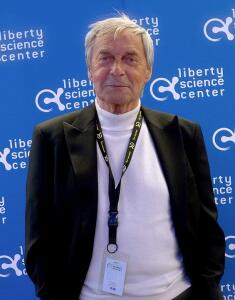 sculptor and architect and was a professor of architecture at the time when he was developing his ingenious creation. Born into a family of creators on July 13, 1944, in Budapest—his mother a poet and his father a flight engineer who designed gliders—it’s no wonder that he himself is a creator.
sculptor and architect and was a professor of architecture at the time when he was developing his ingenious creation. Born into a family of creators on July 13, 1944, in Budapest—his mother a poet and his father a flight engineer who designed gliders—it’s no wonder that he himself is a creator.
The idea for what would become the ‘Rubik’s Cube’ came to Rubik one day in his bedroom at his mother’s apartment in 1974 when he was just 29 years old. He was an instructor of interior design and was teaching his students descriptive geometry, which entails creating two-dimensional models to manually solve and understand three-dimensional geometry problems and their changeable nature. In an effort to help his students better understand these concepts, Rubik began the process of creating something that would be a tangible and movable geometric piece that would display them.
After seeing the potential of the puzzle being more than just a tool for learning, he patented it in 1975, and it was this initial mobile cube that he constructed by hand out of wooden blocks secured by rubber bands—which took him over a month to solve!—that would lead to the craze that would soon ensue.
Rubik began selling his “Magic Cube”, originally known as “Buvos Kocka” in Hungary three years later, which soon became a popular toy in the country during the late 1970s. Wanting to expand but being economically limited in Hungary, Rubik demonstrated his “Magic Cube” at toy fairs where he then licensed his puzzle to the U.S. company, Ideal Toys in 1979. From there the puzzle launched globally in 1980 under the rebranded name, “Rubik’s Cube”, and then things really took off. Within the first three years they had already sold over 100M cubes!
The Rubik’s Cube is a definitive staple of the 1980s, everyone was thoroughly captivated by the entertaining puzzle. Many speedcubing competitions began to pop up, and the first Rubik’s Cube World Championship took place in Budapest on June 5th, 1982. The winner of this initial competition was Minh Thai (USA) who solved the puzzle in 22.95 seconds, and ever since then enthusiasts have been competing to have the quickest solve time—which is now set at 3.47 seconds by Yusheng Du.
Ernő Rubik has created other three-dimensional geometric puzzles like the Rubik’s Magic, Rubik’s Snake, Rubik’s 360 along with some others, but by far his original creation with over 43 quintillion possible solutions has remained in the spotlight.
The Rubik’s Cube is such a beloved and well-known piece that has made many appearances in shows, films, and art throughout the years further making it a historical and pop culture classic. Now, Deadline has announced that producer Ashok Amritraj’s Hyde Park Entertainment Group will team up with Endeavor Content to produce a feature film on the famed cube. Amritraj will also be the executive producer for a Rubik’s Cube-esque TV game show.
Following the spark in classic games brought by the success of the Netflix Original, The Queen’s Gambit notes Variety, the Rubik’s Cube will now take the spotlight. A fan of the cube himself, Amritraj is quoted saying, “I’ve had a personal and nostalgic connection to the Rubik’s Cube from my early days in India. I’m thrilled to partner with Endeavor Content and Rubik’s/Smiley and look forward to creating a wonderful and complex Rubik’s universe.”
There’s still no word as to what exactly the feature will entail or look like, but one thing is for certain, the Rubik’s Cube will continue to be a globally well-known puzzle and toy for generations to come.
If you’d like to know more about Ernő Rubik and his relationship with the cube and the phenomenon, you can read his full interviews in CNA Lifestyle and The New York Times, or for a more in-depth look, you can read his book “Cubed: The Puzzle of Us All” .
SUPPORT SEEFEST
In order to help us meet our commitment to the 2021 Festival, we hope you will consider becoming a SEEfest Cine-Fan member to see us through as we continue to bring you the best film and culture from South East Europe.
Click here to stay in the know as SEEfest 2021 takes shape!
DISCREET POETRY OF CINEMA: VIDEO
A CONVERSATION AFTER THE EXCLUSIVE PREMIÈRE SCREENING OF THE MULTI-AWARDED SHORT DOCUMENTARY FILM THEN COMES THE EVENING
Filmmaker Maja Novaković’s film, Then Comes the Evening beautifully depicts the life of two old women living in the isolated hills of Eastern Bosnia. Nature is the entity with which they speak, listen to, and respect.
The film emphasizes the intangible cultural heritage through the presentation of chants and rituals for taming the adverse weather, hail, and storm. It reflects the simplicity and purity of their way of life, as well as their painstaking work. In the daily activities that they perform, the excellence and distress of these displays are revealed and revived.
Everyday life shows the caring and intimacy the two old women have both in their mutual relations and in relationship with nature. The poetic tone of the frames relies on references from genre scenes of realism paintings, creating documents of bittersweet everyday life in the countryside.
Then Comes the Evening is a discreet, loving witness to the lives of these two old women living isolated on the hills of Eastern Bosnia: their intimacy, their relationship to nature, a whole cultural heritage made out of songs and rituals to tame bad weather, hail, and storm.
Maja Novaković’s stunning debut has garnered 32 awards and 52 nominations, won over audiences at all major documentary festivals around the world, and qualified for the Academy Award® in the Best Short Documentary category.
The program began with a screening of the short documentary that was then followed by a conversation with Vera Mijojlić, Festival Director of the South East European Film Festival (SEEfest) in Los Angeles, and Logan Crow, Executive Director of The Frida Cinema in Santa Ana.
The live, virtual event was presented on December 20, 2020 on the co-watch platform Beem.
SUPPORT SEEFEST
In order to help us meet our commitment to the 2021 Festival, we hope you will consider becoming a SEEfest Cine-Fan member to see us through as we continue to bring you the best film and culture from South East Europe.
The Best Orthodox Christmas Bread – Recipe
Use this recipe to make Česnica
During Orthodox Christmas on January 7th, many Serbian families prepare a traditional Christmas bread known as Česnica (ches-nee-tsa). It’s an egg-based bread similar to brioche. It’s fluffy on the inside with a shimmering and crunchy crust.
A unique tradition is associated with Česnica. A coin is kneaded into the dough before the bread is baked and served. The coin represents good luck in the year to come, as well as prosperity, wealth, and health. At the table, each guest grips onto the bread and tears off a piece. So far in our family, the recipient of the coin each year has truly had an exceptional year.
To prepare Česnica, here’s everything you’ll need and how to make it.
Ingredients for Česnica:
- 1kg flour
- 2 eggs
- 8 tbs sugar
- 2 tsp salt
- 1 cup oil
- 500 mL of milk
- 3 tsp active dry yeast
- +1 extra egg for egg wash & 1 tbs of butter
How to Make Česnica:
- Mix all of the ingredients until you get a sticky, stretchy dough. If the dough is too dry, add more milk.
- Knead the dough. (don’t forget to add the lucky coin in this step!)
- Cover the dough and let it rise for an hour.
- Slice off some of the dough for decoration (approx 1/4 for a braid). In my family, we keep it simple and remove approximately 1/4 for a large braid that we wrap around the top of the bread. Other families opt for more intricate details like leaves, smaller braids, and a cross. In this case, you’ll want to use a separate dough free of yeast.
- Create your decoration and attach it to your dough with an egg wash (cracked, whisked egg). Cover with egg wash and dots of butter.
- Bake in a pre-heated oven at 400 degrees Fahrenheit for the first 10 minutes and then 350 for the next 50-60 minutes. 20-30 minutes in, you may want to cover the bread with tin foil so the crust does not burn.
- Let cool and enjoy!
If you make your own Česnica, take a photo and tag us @SEEfest on Instagram so we can drool at your delicious Christmas bread creations.
A happy new year and happy holidays everyone!
Support SEEfest
In order to help us meet our commitment to the 2021 Festival, we hope you will consider becoming a SEEfest Cine-Fan member to see us through as we continue to bring you the best film and culture from South East Europe.
Sign up to stay in the know as SEEfest 2021 takes shape!
Celebrating SEEfest Accomplishments in 2020
A Time to Reflect
As 2020 comes to a close, it seems to be the perfect time to acknowledge and celebrate that we’ve made it through one of the most difficult years of our lives.
We want to share some of SEEfest’s accomplishments this past year, some against all odds.
In February as we were finalizing details for our 15-year anniversary celebration, it became clear it wasn’t going to be happening as we imagined.
SEEfest was among the first film festival to pivot and successfully switch to an online festival, partnering with one of the world’s leading platforms, SHIFT72.
Pushing the Festival back, the 2020 edition with 51 films, most of them North-American or U.S. premieres, ran from July 15 to August 16.
Virtual juried awards were organized with 21 industry professionals from Los Angeles, New York, Chicago, Austin, Oakland, and Canada, Sweden, and Spain.
The popular annual Cultural and Literary Salon exploring the ‘Boundaries of Belonging’ took place on Zoom.
Seven online workshops dedicated to industry Accelerator for new projects engaged filmmakers from Canada, Greece, Romania, Serbia, and L.A.-based Bulgarian-Armenian, Serbian, Filipino-Romanian, Peruvian-American and African American filmmakers.
Plus…
- Four film premieres took place on the Virtual Cinema platform, in partnership with Synergetic Films.
- Two special online events were organized in November and December to highlight prominent Oscar contenders from the S.E. European region.
- Through direct SEEfest advocacy, several festival films were acquired by U.S. distributors, with special legacy programs in pre-production.
- New interns joined SEEfest in 2020 from CSU Long Beach, CSU Northridge, UC Santa Cruz, and Boston University.
- A new partnership was initiated with BEEM, the innovative online platform for film distribution and presentation.
- Behind the scenes, we’ve been working on major technological upgrades in marketing, fundraising, the SEEfest website, and social media.
- A strategic initiative was launched to expand outreach to diverse communities both in Southern California and across the United States.
In a year of uncertainty, we continuously asked ourselves, how can we best serve our audience.
As a nonprofit festival, we bumped up against new and unexpected costs required in order to make the changes we considered important in order to meet our mission.
We are grateful for your support and the partnership of our sponsors who helped us make it through the year.
In order to help us meet our commitment to the 2021 Festival, we hope you will consider making a year-end donation to see us through as we continue to bring you the best film and culture from South East Europe.
Stay tuned for details as SEEfest 2021 takes shape!
Sending you best wishes for a safe and happy 2021,
Vera Mijojlic and the SEEfest Team
Exposé COLLECTIVE | Video
A conversation about the film COLLECTIVE, investigative journalism, and filmmakers who document their work
In 2015, a fire at the Colectiv nightclub in Bucharest, Romania, killed 27 people and injured 146. Romanian Health Minister assured the nation that the burn victims would receive the highest level of healthcare. Instead, another 37 club attendees died in the hospitals which used many times diluted disinfectant in ICUs which led to infections and sealed the fate of the burn victims.
Filmmaker Alexander Nanau’s powerful film documents the painstaking work of Sport Gazette’s investigative journalists, who uncovered the shocking scandal behind the tragedy. Prominently featuring the persistent Catalin Tolontan who pursued the powers that be at every turn, their account of corruption at all levels of government led to one of the largest public protests that toppled the government, and brought in a patient rights advocate as the new Health Minister.
The cinematic power of COLLECTIVE is as gripping as Tom McCarthy’s academy award-winning narrative, SPOTLIGHT. The Gazette’s journalists who pursue the layers of corruption in Romania are as captivating as the Globe reporters as they uncover the depths of deception from the Catholic Church.
The program features excerpts from relevant films and spotlights investigative journalism in South Eastern Europe. Mocha Jean Herrup, founder of the New Bedford Film Society and content producer for the South Coast Film Forum, and Chale Nafus, founding board member and long-time director of programming, Austin Film Society, join in the conversation with Vera Mijojlic, festival director, South East European Film Festival, SEEfest, Los Angeles, CA.
The live event was presented in November 2020 on the co-watch platform Beem.
Collective is available for at-home streaming. Collective is Romania’s official Oscar entry for Best International Feature.
SUPPORT SEEFEST
If you enjoy our programming and appreciate the cultural mission of SEEfest, consider making a donation to support our work so we can continue to serve you in the coming years. Thank you!
FRIENDS OF SEEFEST

SEEfest program and activities are supported, in part, by the California Arts Council, a state agency; Los Angeles County Board of Supervisors through the Los Angeles County Department of Arts and Culture; and by an Arts Grant from the City of West Hollywood. Special thanks to ELMA, and the Hollywood Foreign Press Association for their continued support of our programs.
Sign up for SEEfest notifications for events and festival news. Follow SEEfest on Instagram and Facebook where we post SEE news as it happens!
50 Binge Worthy Films from South East Europe
3 More Days – SEEfest 2020 Closes on August 16
Get the best deal with all 50 films for $55 before our online festival ends on August 16. Don’t miss the boat! Sail away from the pandemic worries and indulge your inner genre fan in Predrag Ličina’s sci-fi horror spoof The Last Serb in Croatia, or urban crime tale in Slovenia’s The Corporation from director Matej Nahtigal. Hungary’s Pilátus from director Linda Dombrovszky touches the emotional core of an aging mother and her successful but emotionally distant daughter, Serbia’s Common Story from director Gordan Kičić navigates modern marriage with much-needed humor, while Esther Turan and Anna Koltay chart Hungarian youth subculture in BP Underground – Electronic Music.
Get your movie travel pass to South East Europe!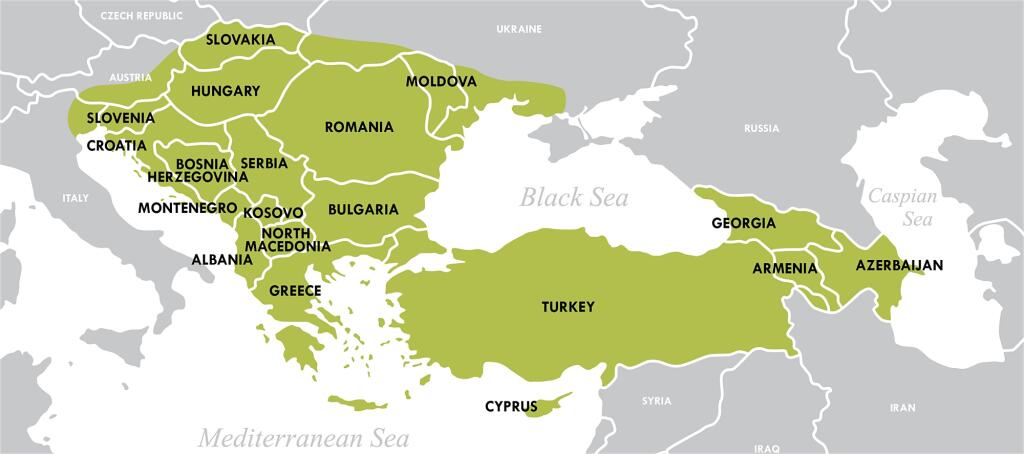

Growing up hard, searching for directions
Renowned Serbian documentarian Ivana Todorović seamlessly transitioned to short fiction in her delicate yet powerfully told tale of surviving domestic abuse, When I’m at Home, while Alexandros Kakaniaris offers his own take on growing up hard in The Dude, a young boy’s attempt to break into the world of adults.
Making sense of politics
Join Romanian grandfather telling his American grandson about his role in the 1989 revolution that overthrew the Communist dictatorship, My Father’s Revolution by Diana Nicolae; and pair it up with a satirical animated short turning the notion of freedom and democracy on its head in Moldovan appropriately titled Freedom from directing duo of Mircea Bobînă & Vadim Țigănaș. While browsing our shorts program, stop by Igor Ćorić’s winning short animation Passage (Serbia), and end on a touching note in Henning Backhaus’s delightful, innovative nod to diversity in Austrian live-action and animation short, The Best Orchestra in the World.
SUPPORT SEEFEST
If you like our programming orientation and the cultural mission of SEEfest, consider making a donation to support our work. Thank you!
FRIENDS OF SEEFEST





SEEfest program and activities are supported, in part, by the California Arts Council, a state agency; Los Angeles County Board of Supervisors through the Los Angeles County Department of Arts and Culture; and by an Arts Grant from the City of West Hollywood. Special thanks to ELMA, and the Hollywood Foreign Press Association for their continued support of our programs.
Follow SEEfest on Instagram and Facebook where we post SEE news as it happens!
SEEfest At Home – Spotlight on Short Films, An Inventor and An Acrobat
The clock is ticking…SEEfest 2020 ends it’s run on August 16
With the festival halfway through, make sure you use your passes within the next 14 days! Once we hit Aug 16, our online edition will no longer be available. So get your pass and popcorn, and spend the night with three police units patrolling the capital in Stephan Komandarev’s Rounds (Bulgaria), revisit history in Croatian Schindler’s List-type story, The Diary of Diana B. about the unsung heroine of WWII, follow an orphan’s journey to her long-lost family in Come Find Me (US/Romania) and meet the first-ever indigenous Roma woman to graduate from the Academy of Dramatic Arts in the Bulgarian documentary My Gypsy Road.
Get your movie travel pass to South East Europe!
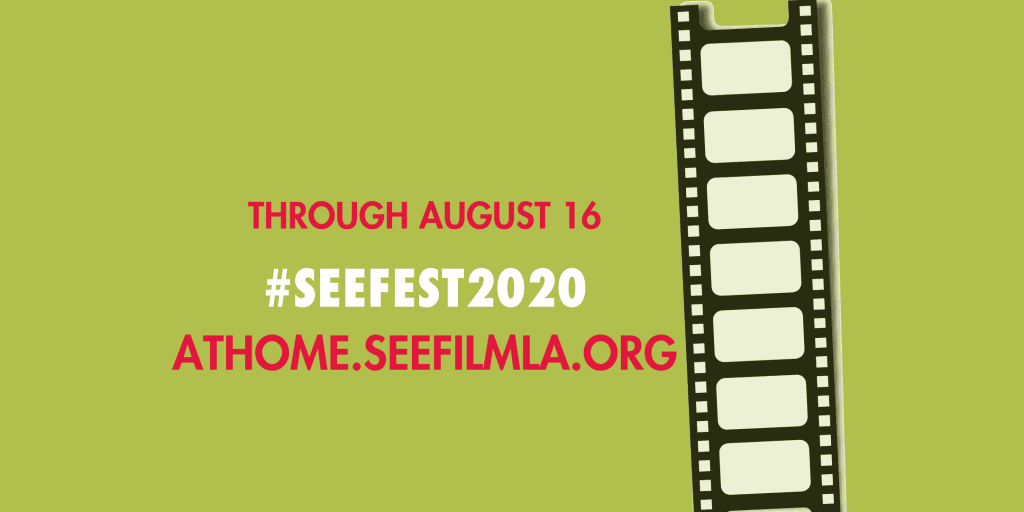

The flamboyant inventor, and an old-fashioned acrobat
The Century of Dreams protagonist invented the perfume spray bottle, the plastic zipper, the lighter with a side-button and 400 other patents, was also among the first airbag developers and managed to socialize with movie stars in Monte Carlo. A very different man is the subject of Greek documentary Spiros and the Circle of Death, a throwback to an older, dying art of motorcycle death-rides and family tradition of circus acrobats.
Spotlight on short films: nature, politics, techno absurd, sci-fi, and more!
Spend some time with the poetic and powerful ode to nature Then Comes the Evening (Serbia/Bosnia Herzegovina), devastating political satire Zimnicea (Romania), laugh-out-loud Best Game Ever (Hungary), and Two (USA/Turkey) which tips its hat to sci-fi fans. Each of our three program blocks with diverse short vignettes offers plenty to explore.
SUPPORT SEEFEST
If you like our programming orientation and the cultural mission of SEEfest, consider making a donation to support our work. Thank you!
FRIENDS OF SEEFEST





SEEfest program and activities are supported, in part, by the California Arts Council, a state agency; Los Angeles County Board of Supervisors through the Los Angeles County Department of Arts and Culture; and by an Arts Grant from the City of West Hollywood. Special thanks to ELMA, and the Hollywood Foreign Press Association for their continued support of our programs.
Follow SEEfest on Instagram and Facebook where we post SEE news as it happens!
Movie Marathon at Your Home
A movie marathon curated for movie lovers: Legacy, Zana, Omar and Us, and Open Door
Fans of genre films will find a lot to be appreciated in Dorian Boguta’s debut feature gem Legacy, an atmospheric psychological thriller from Romania with Teodor Corban in the role of the world-weary detective, crime genre’s iconic character.
Two SEEfest jury award-winners: Kosovo’s Zana, by newcomer Antoneta Kastrati and starring the captivating Adriana Matoshi as the troubled survivor; and Turkey’s refugee saga Omar and Us by the directing duo Maryna Er Gorbach and Mehmet Bahadir Er.
Another strong debut comes from Albania’s Florenc Papas whose women-centric Open Door journeys into a patriarchal society by staying firmly focused on the inner world of its women.
Get your movie travel pass to South East Europe!
The epic wind Bora of Northern Adriatic and Turkey’s Queen Lear
These two films shared SEEfest 2020 Jury award for Best Documentary, and it is easy to see why: Bora, Story about a Wind follows the eponymous gale around the intersection of cultures in Northern Adriatic, while Queen Lear takes us to rural Turkey where local women take part in the production of Shakespeare’s play with their own twist. Both films are blowing much-needed laughter into the cinematic sails and regaling us with entertaining and uplifting stories.
Buy festival PASS to these, and other movies HERE.
Poetry behind SEEfest 2020 film: Pumpkin on the hot roof of the world
Celebrated Slovenian poet Tomaž Šalamun (1941-2014), ‘a leading figure of postwar neo-avant-garde poetry in Central Europe and internationally acclaimed absurdist,’ is the subject of the documentary film featured at SEEfest 2020 – Pumpkin on the hot roof of the world: Poetry and the Eternal Life of Tomaž Šalamun. He believed passionately in the power of poetry to liberate the human spirit, and so do we.
Nine of Šalamun’s books of poetry have been translated into English. He lived in the U.S. for a while, exhibited his work at the Museum of Modern Art in New York, and taught at the University of Pittsburgh.
Watch this entertaining cinematic portrait that bridges Central Europe and America through world-class poetry.
SUPPORT SEEFEST
If you like our programming orientation and the cultural mission of SEEfest, consider making a donation to support our work. Thank you!
FRIENDS OF SEEFEST





SEEfest program and activities are supported, in part, by the California Arts Council, a state agency; Los Angeles County Board of Supervisors through the Los Angeles County Department of Arts and Culture; and by an Arts Grant from the City of West Hollywood. Special thanks to ELMA, and the Hollywood Foreign Press Association for their continued support of our programs.
Follow SEEfest on Instagram and Facebook where we post SEE news as it happens!






